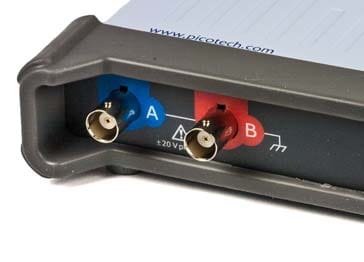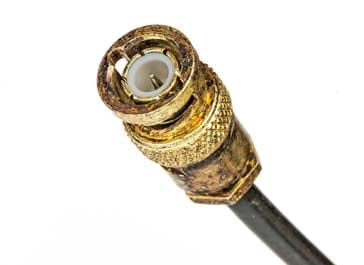BNC Connector
- an overview, information or tutorial about the BNC connector used for making RF connections.
RF Coax Connectors Includes:
RF connectors
RF connector specifications
BNC connector
TNC connector
N-type connector
SMA connector
SMB connector
MCX connector
Precision connectors
UHF connector
F-type
Related connector types:
Other connectors
The BNC coax connector is one of the most widely used RF connectors today. It is very easy and convenient to use, and offers a very high level of performance. The BNC connector is used on test equipment for everything from oscilloscopes to audio generators, and power meters to function generators. In fact BNC connectors are used in applications where coaxial or screened cable is required, and particularly for RF applications.
The BNC connector has many attributes. One its chief mechanical attributes is that it uses a bayonet fixing. This is particularly useful because it prevents accidental disconnection if the cable is pulled slightly or repeatedly moved.
The BNC is also what is termed a constant impedance connector. This means that it has the same characteristic impedance across the whole of the connector. Coax cable has what is called a characteristic impedance. Accordingly any RF signals travelling along a coax cable will not see any impedance changes as they pass through the BNC connector. This is particularly important for RF applications as it will result in few reflections and a lower level of loss.

BNC development
The BNC connector was developed in the late 1940s and it gains its name from a combination of the fact that it has a bayonet fixing and from the names of the designers, the letters BNC standing for Bayonet Neill Concelman. It has also been shown to stand for Bayonet Navy Connector in some references.
The BNC connector is essentially a miniature version of the C connector which was in turn a bayonet version of the N-type connector.
The BNC connector was developed as a result of the need to provide a high quality, robust connector that would be capable of being used in a wide variety of applications. Additionally it needed to be smaller than either the N-type or C-type connectors which were much larger.
BNC specifications
The specifications of the BNC connector naturally vary from one manufacturer to another and it is always best to ensure that the particular component being purchased is suitable for the intended application. However there are a number of guidelines that can be used. The connector comes in two basic types:
- 50 ohm
- 75 ohm
Of the two versions of the BNC connector, the 50 ohm version is more widely used. Often the BNC connector is specified for operation at frequencies up to 4 GHz and it can be used up to 10 GHz provided the special top quality versions specified to that frequency are used. However it is wise to fully check the specification.
| Basic BNC Specification Summary |
|
|---|---|
| Parameter | Specification |
| Cable Type | Coaxial |
| Securing | Bayonet fit |
| Typical operating frequency range | 0 - 4 GHz |
| Diameter (Male) | 14.0 mm / 0.570 in |
| Diameter (Female) | 11.1 mm / 0.436 in |
BNC connector formats and variants
BNC connectors come in a variety of formats. Not only are there plugs and sockets but there are also adapters and also other items such as attenuators.
BNC plugs are designed not only for the required impedance, but also to accept a particular coax cable format. In this way all the internal piece parts are compatible with the coaxial cable used. It is therefore necessary to specify the BNC plug for use the cable to be used. Although there is some latitude, it is naturally best to select the correct cable format.
In addition to this there are straight and right angled variants. Of these the straight connectors are the most widely used, although right angled connectors where the cable leaves the plug at right angles to the centre of the connector centre line are also available. These are ideal in many applications where the cables need to leave the connector in this manner to ensure cables are in a tidy fashion, or where space is at a premium. Unfortunately right-angled connectors have a marginally higher level of loss than their straight through counterparts. This may not be significant for most applications, but at frequencies near the operational limit of the connector there may be a small difference.
The sockets or female BNC connectors also come in a number of flavours. The very basic BNC connector consists of a panel mounting assembly with a single connection for the coax centre. The earthing is then accomplished via the panel to which the connector is bolted using a single nut. Large washers can be used to provide an earth connection directly to the connector. Some of these connectors may also use four nuts and bolts to fix them to the panel. These arrangements are only suitable for low frequency applications, and not for RF. Where impedance matching and full screening is required. Bulkhead mounting connectors where coaxial cable entry is provided are available for this. Again these are available for a variety of cable dimensions and the correct type should be used.
There are two main variants of the BNC connector assembly method:
- Compression gland type
- Crimp type

BNC plug assembly
The assembly of a BNC connector will depend upon the type that is to be used. Both types require assembling wit reasonable care, and the crimp style requires a crimp tool for its assembly.
The compression gland type of BNC connector has the centre pin of the connector which is usually a solder pin and the braid and sheath of the cable are held by an expanding compression gland fixed by a nut at the rear of the connector. This type of connector by its nature can cope with a (limited) range of cable sizes and requires no specialised tooling to assemble. This makes it ideal for small quantity production, either for one off cables for laboratory use of for limited production runs.
The crimp BNC connector has the centre pin which is normally crimped to the centre conductor. This crimped pin is then pushed into position through an inner ferrule which separates the inner insulation sheath and the braid of the cable. An outer ferrule is then crimped over the braid and outer insulation which fixes the cable to the connector. Greater accuracy is required for the crimp style connectors and therefore the correct connector variant must be chosen for the cable being used. This may result in a crimp style connector not being practicable for some cable types. In addition to this the assembly requires the use of the correct crimping tools to ensure that the connector is correctly crimped. While these connectors are always preferred for large production runs because they are much faster to assemble, it is not possible for them to be reworked for obvious reasons.
For both styles of BNC connector it is essential that the exact amount of insulation is stripped from each section to ensure accurate assembly and the required RF performance.
Ancilliaries
Finally a variety of BNC adapters and other ancillary items are available. One popular BNC adapter is the straight through adapter, allowing two cables with male connectors fitted to be connected end to end. Other "T" adapters are also available. These have a male plug at the bottom of the "T" and two female connections at either end of the horizontal of the "T". These are ideal for use with oscilloscopes where a through connection needs to be measured, and the "T" BNC adapter enables the required connections to be made.
In addition to this a variety of inter-series adapters are available to enable transitions to be made between different connector types. These inter-series connector adapters can be very useful as it is not uncommon for two or more varieties of connector to be used in a laboratory or work area.
The BNC connector is probably the most widely used RF connector today. It is easy and convenient to use, it is robust, cost effective, and relatively easy to assemble, although a little care is needed. As a result, the BNC connector has become, probably the standard RF connector is use today.
More Electronic Components:
Batteries
Capacitors
Connectors
Diodes
FET
Inductors
Memory types
Phototransistor
Quartz crystals
Relays
Resistors
RF connectors
Switches
Surface mount technology
Thyristor
Transformers
Transistor
Unijunction
Valves / Tubes
Return to Components menu . . .



